We are by now all familiar with the great wave of corporate underwriting of the contemporary art scene, and this was much in evidence in the run up to the official opening of the Biennale.
An early event was the unveiling of the Ca' Corner della Regina, a beautiful palazzo from the early 18th century now undergoing conservation supported by the Prada Foundation. Prada will use the space to promote contemporary art, including their own collection.
While much of the collection could be hanging anywhere, Prada does have examples in depth of the Italian art movement known as Arte Povera, and the best blend of old and new on show today was in the main runway -- er, central hall -- where the frisky putti and Corner family members painted on the ceiling consorted with the severe geometries of Pino Pascali's 1960s floor piece (above).
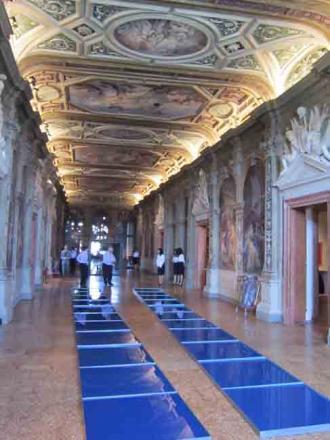
Pino Pascali, Confluences (1967). aluminum and aniline-dyed water.
Photo: Marjorie Och.
The best known corporate collection of contemporary art in Venice these days is that of French industrialist Francois Pinault, whose art is now housed in two grand spaces, the former customs house at Punta della Dogana, and the Palazzo Grassi. At the latter venue, a very nice luncheon was laid on for the press yesterday as a prelude to the official opening of the newest exhibition of M. Pinault's collection. The highlight is an enormous textile work by Joana Vasconcelos that fills the multi-story entrance way, but that was too difficult to photograph, so we offer instead Takashi Murakami hamming it up for the photographers. He seems to take his work about as seriously as it deserves.
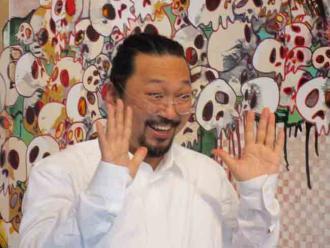
Takashi Murakami, 727-272 (The Emergence of God at the Reversal
of Fate) (2008-09), acrylic and gold leaf on canvas mounted on wood.
Photo: Marjorie Och.
But not all was corporate and commercial. Just around the corner from the Pinault event, several countries' pavilions were receiving finishing touches.
The most interesting by far was the work of one of two artists representing Cyprus this year, Elizabeth Hoak-Doering, who was kind enough to take a break from last-minute installation tweaks to talk with us. Hoak-Doering brings her background in anthropology to questions of agency and the object/viewer relationship. Borrowed objects -- a hat rack, a school desk, an iron bed -- from Cypriots on both sides of the Greek/Turkish divide are turned into drawing machines. The gallery visitor (and hidden motion detectors) sets these disparate things rotating, and graphite and mylar record the motion, like EKGs. The delicate drawings that result are open to interpretation, and each work might be considered an Emotion detector.
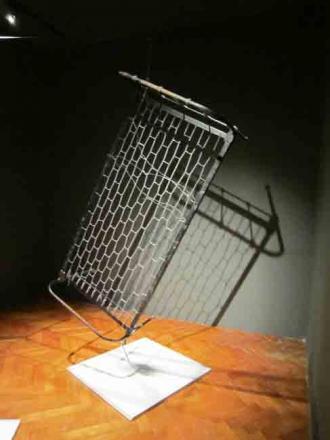
Elizabeth Hoak-Doering, Amanuensis: Bed for under a tree (2009),
iron bed; mylar, graphite, relays and motion detector.
Photo: Marjorie Och.
The Taiwan pavilion hosts several artists all working with sound, and the "Sounds Edgy!" party on Tuesday night was a spirited warm up for the press preview that begins tomorrow. A DJ created danceable electronica, and both Heineken beer and piles of CDs of various Taiwanese indie music groups were free for the taking.
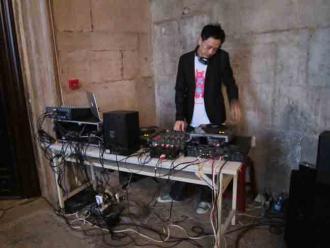
DJ@llen at Sounds Edgy! party, Taiwan pavilion. Photo: Marjorie Och
Among the few visual artworks, the most affecting was Hong-Kai Wang's video of retired factory workers reflecting on their lives by creating soundscapes in their former workplace. Like Hoak-Doering's work, questions of agency and empowerment are thoughtfully and poetically addressed. We will hope for more art on this level when the Giardini opens tomorrow.
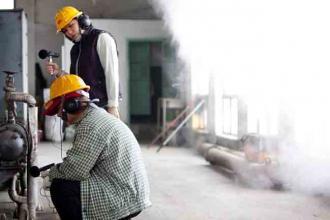
Hong-Kai Wang, Music While We Work (2011) video.
Video still: courtesy artist and You-Wei Chen.
Reporting from Venice, Marjorie Och (University of Mary Washington) and Preston Thayer (New Mexico State University)